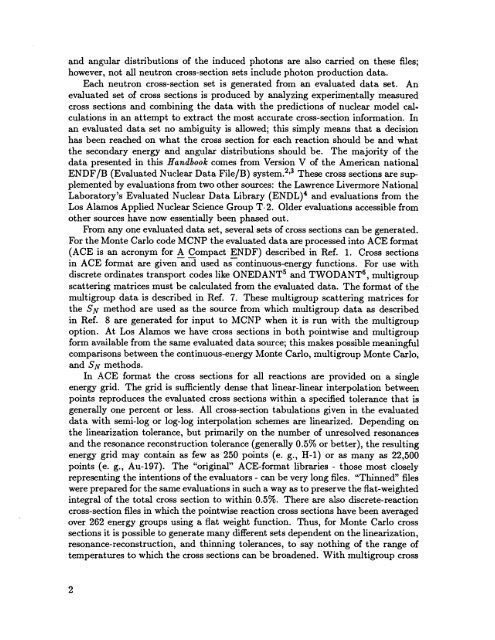A Nuclear Cross Section Data Handbook
A Nuclear Cross Section Data Handbook
A Nuclear Cross Section Data Handbook
You also want an ePaper? Increase the reach of your titles
YUMPU automatically turns print PDFs into web optimized ePapers that Google loves.
and angular distributions of the induced photons are also carried on these files;<br />
however, not all neutron cross-section sets include photon production data.<br />
Each neutron cross-sect ion set is generated from an evaluated data set. An<br />
evaluated set of cross sections is produced by analyzing experimentally measured<br />
cross sections and combining the data with the predictions of nuclear model calculations<br />
in an attempt to extract the most accurate cross-section information. In<br />
an evaluated data set no ambiguity is allowed; this simply means that a decision<br />
has been reached on what the cross section for each reaction should be and what<br />
the secondary energy and angular distributions should be. The majority of the<br />
data presented in this <strong>Handbook</strong> comes from Version V of the American national<br />
ENDF/B (Evaluated <strong>Nuclear</strong> <strong>Data</strong> File/B) system. 2$3These cross sections are supplemented<br />
by evaluations from two other sources: the Lawrence Livermore National<br />
Laboratory’s Evaluated <strong>Nuclear</strong> <strong>Data</strong> Library (ENDL)4 and evaluations from the<br />
Los Alamos Applied <strong>Nuclear</strong> Science Group T-2. Older evaluations accessible from<br />
other sources have now essentially been phssed out.<br />
From any one evaluated data set, several sets of cross sections can be generated.<br />
For the Monte Carlo code MCNP the evaluated data are processed into ACE format<br />
(ACE is an acronym for —— A Compact — ENDF) described in Ref. 1. <strong>Cross</strong> sections<br />
in ACE format are given and used as cent inuous-energy functions, For use with<br />
discrete ordinates transport codes like 0NEDANT5 and TWODANTG, muhigroup<br />
scattering matrices must be calculated from the evaluated data. The format of the<br />
multigroup data is described in Ref. 7. These multigroup scattering matrices for<br />
the SN method are used as the source from which multigroup data as described<br />
in Ref. 8 are generated for input to MCNP when it is run with the multigroup<br />
option. At Los Alamos we have cross sections in both pointwise and multigroup<br />
form available from the same evaluated data source; this makes possible meaningful<br />
comparisons between the cent inuous-energy Monte Carlo, multigroup Monte Carlo,<br />
and SN methods.<br />
In ACE format the cross sections for all reactions are provided on a single<br />
energy grid. The grid is sufficiently dense that linear-linear interpolat ion between<br />
points reproduces the evaluated cross sections within a specified tolerance that is<br />
generally one percent or less. All cross-section tabulations given in the evaluated<br />
data with semi-log or log-log interpolation schemes are linearized. Depending on<br />
the linearization tolerance, but primarily on the number of unresolved resonances<br />
and the resonance reconstruction tolerance (generally 0.5$%0or better), the resulting<br />
energy grid may contain as few as 250 points (e. g., H-1) or as many as 22,500<br />
points (e. g., Au-197). The “original” ACE-format libraries - those most closely<br />
representing the intentions of the evaluators - can be very long files. “Thinned” files<br />
were prepared for the same evaluations in such a way as to preserve the flat-weighted<br />
integral of the total cross section to within 0.59’0. There are also discrete-reaction<br />
cross-section files in which the pointwise reaction cross sections have been averaged<br />
over 262 energy groups using a flat weight function. Thus, for Monte Carlo cross<br />
sections it is possible to generate many different sets dependent on the linearization,<br />
resonance-reconstruction, and thinning tolerances, to say nothing of the range of<br />
temperatures to which the cross sections can be broadened. With multigroup cross<br />
2

















